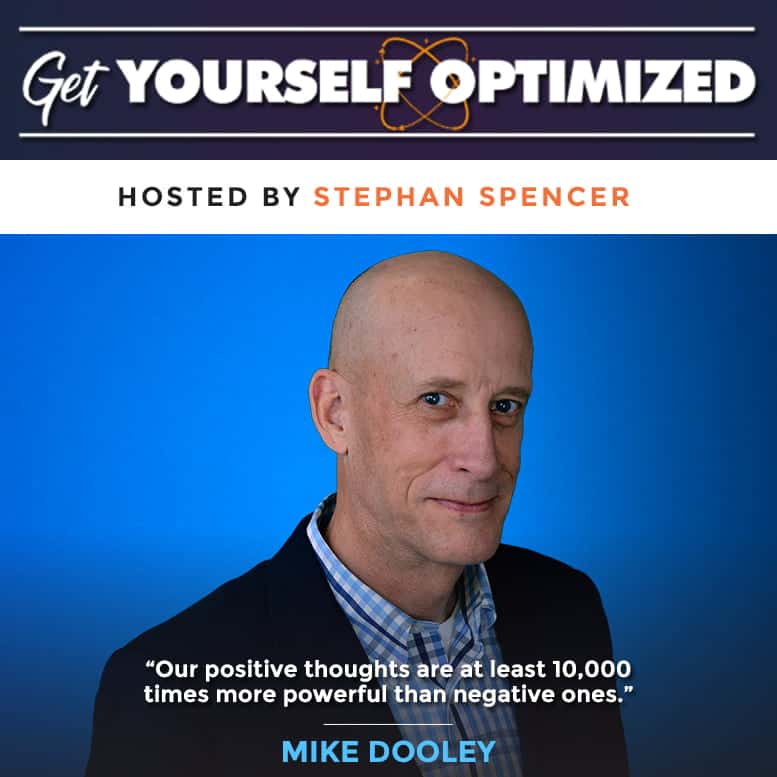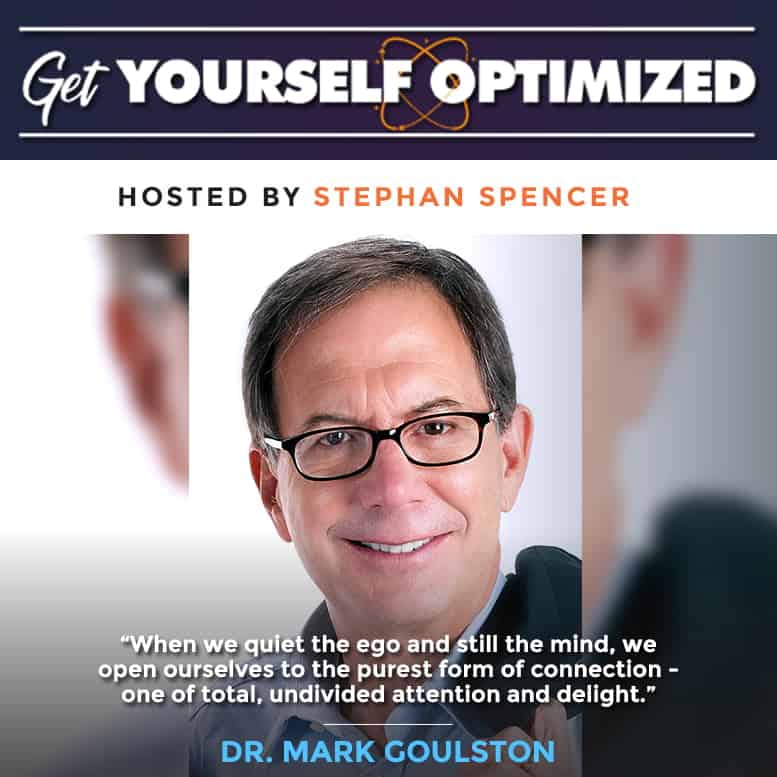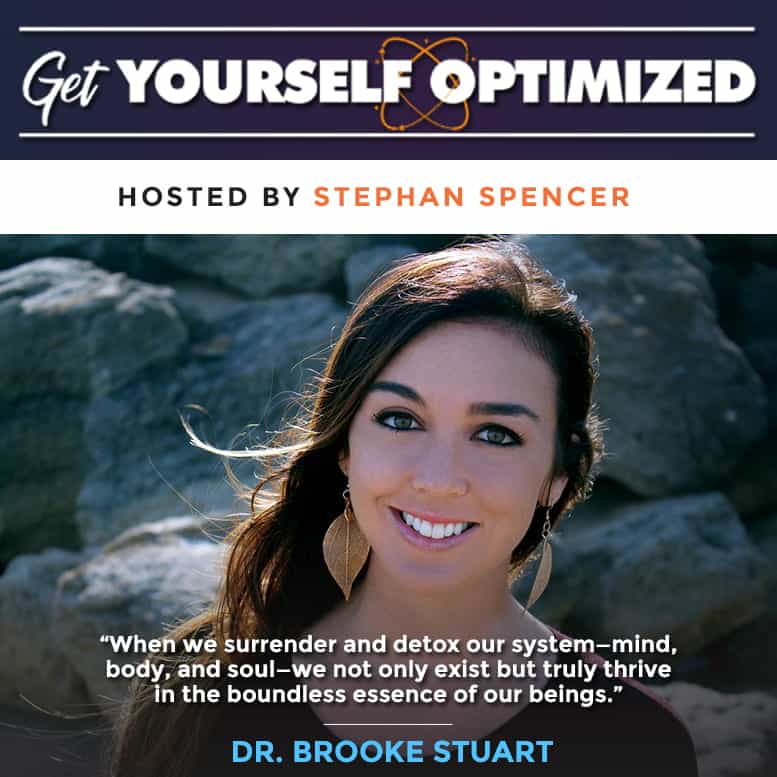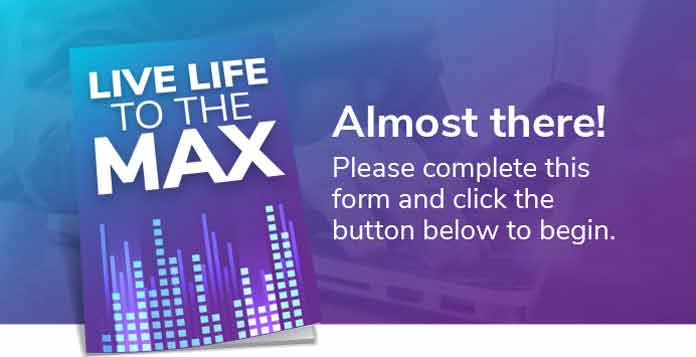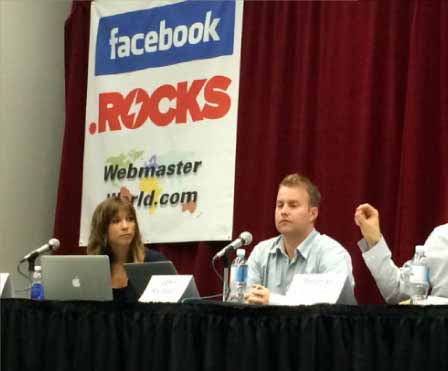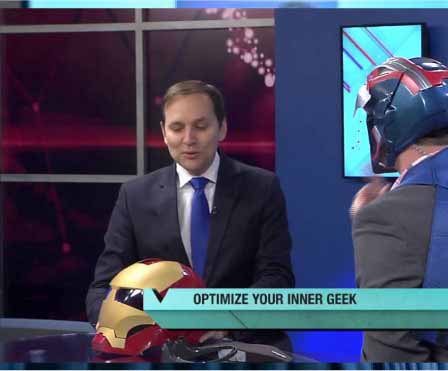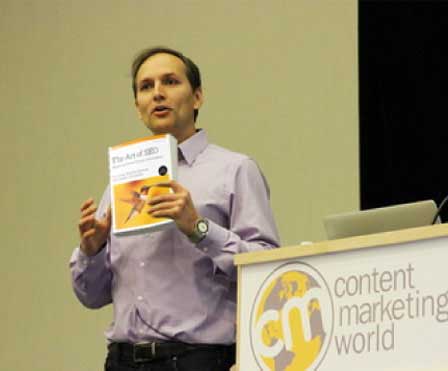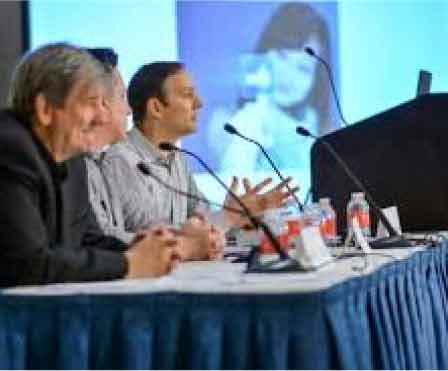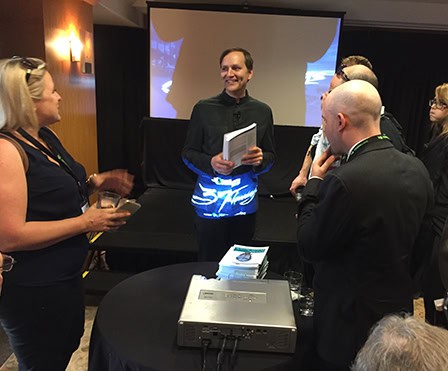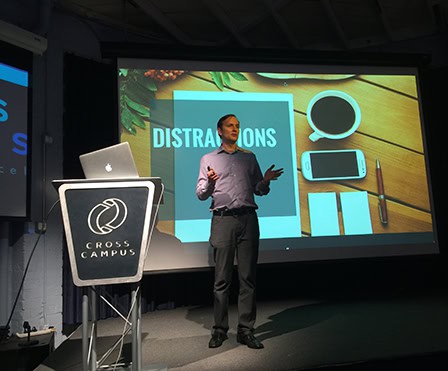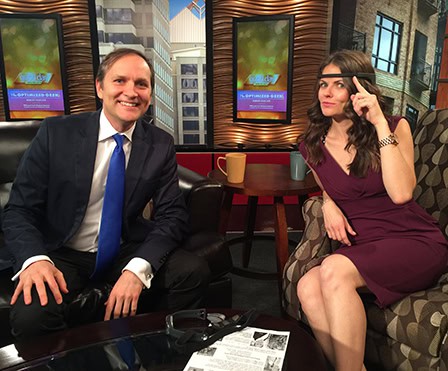Transcript
Hello and welcome to Get Yourself Optimized, I’m your host Stephan Spencer. Today, I have the distinct pleasure of inviting Hal Elrod onto the show. I’m just floored by Hal’s story. Hal died at the age of 20 after being hit head-on by a drunk driver at 70 miles an hour. He died for six minutes, broke 11 bones, and was told by doctors that he would never walk again. Not only did he walk, but he also ran a 52-mile ultra-marathon. He became a hall of fame business achiever, an international keynote speaker, a number one bestselling author of The Miracle Morning. It’s one of the highest-rated books on Amazon with over 13,000 five star reviews. Hal, thank you for joining us today.
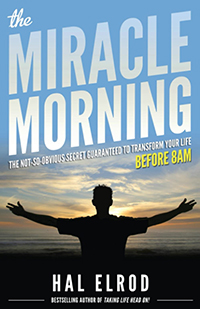
Stephan, it really is my pleasure, thanks for having me. Everybody tuning in, thanks for listening.
Yeah, let’s start with your story because that’s just an incredible story of struggle going from just living your life to having everything shift when you got hit with that drunk driver. Can you just walk us through that story and how The Miracle Morning book came out of that experience?
Absolutely. In the book, I talk about what I call my two rock bottoms that I’ve had in my life. The first one was the car accident, the second one was the 2008 US economy crash. Those are what led to The Miracle Morning. The crash, very directly and the accident very much set this foundation of what my life was going to be about, if you will. By the way, before I share this, if you’re listening, the way that I define a rock bottom so that you can relate is we’ve all suffered from rock bottoms. Fortunately or unfortunately, there’s more on the way which is simply, I define it as any moment of adversity that is beyond what you’ve ever experienced before. It’s more difficult, more challenging, it tests you, tests your will, tests your character, all of that. You might even really doubt yourself and have to overcome that.
For me in 1999, I started selling Cutco kitchen knives. Not door to door but referrals, in home, and the closest thing to door-to-door. One night, a year and a half into the career, I was giving a speech at a sales conference. That night, I got into my brand new Ford Mustang after the speech. The speech went great. I was on top of the world, feeling like a million bucks. I’m driving home in my brand new Ford Mustang. The drunk driver got on the freeway going the wrong way, hit me head-on at 70 miles an hour. The worst was actually yet to come. My car spun off the drunk driver because we hit off-center. Half of his front bumper hit the half of my front bumper. The two driver sides hit head-on. It sent my car spinning and the car behind me crashed into my door at 70 miles an hour directly into my driver’s side door. It crushed the left side of my body. That’s where I broke 11 bones, punctured my lung, ruptured my spleen, almost completely severed my ear, bled to death.
The paramedics, the rescue crew resuscitated me, took me to the hospital, underwent emergency surgery. They said six days later I came out of the coma to find out I’d have a permanent brain damage, broken bones, very significantly, horrifically scarred being told I would never walk again. Anybody, it’s challenging but at 20 years old I’m like, “Whoa, I had a lot of goals, that involved walking. This is not at all part of the plan.” I was faced with the same choice that we’re all faced with which is either we accept our reality as it’s happening, and we accept it which then allows to be at peace with it. We make the best of it, we focus on what’s in our control, not what’s in the past, whether it’s five minutes of five years, or five decades. Focus on what is in our control and making the best of it.
For me, I decided if I never walk again, I can’t change that, if that’s what happens. But I can choose my attitude and my quality of life depends on that. I think for all of us that’s such an important lesson to realize that our quality of life has much less to do with what’s going on around us and almost everything to what’s going on inside of us. I told the doctors, “Look, doctors, I will be the happiest person you’ve ever seen in a wheelchair if that is the case but I am not accepting that until I have to.” Meaning, it does just happen like, give me six months to a year, I’m going to be optimistic, I’m going to visualize walking again, I’m going to imagine, I’m going to think about it, I’m going to maintain faith that it’s possible while simultaneously being completely at peace with it not being possible. Kind of an art there, both at the same time.
Two weeks later from me waking up out of the coma, three weeks after the crash, the doctors came in with routine x-rays, they said, “We don’t know how to explain this but your body is healing so quickly that we’re going to let you walk tomorrow.” I was thinking like six months to a year was my optimistic calculation, not three weeks. Three weeks after the crash I took my first step and the rest is history. That was in the hospital, I decided, why did this happen to me? I felt the sense of responsibility that I’ve been given a second chance, I’m going to dedicate my life to trying to help other people and share my story, and really fulfill my potential from this point on so that I’m qualified to help other people fulfill their potential, whether that’s my children I hope to have someday, my family. Maybe if I end up writing a book or something like that, in that way I’ll be able to help others.

You did, you wrote a book, which has helped countless numbers of people around the world. Tell us a bit more about that book and what it does different from other books and some of the impacts it’s had.
Yeah, that’s actually my second book, you’re referring to The Miracle Morning, which is my second book. My first book was published in 2006, Miracle Morning is 2012. 2006, I wrote my first book, Taking Life Head On!. I think I was 25 when I published. Taking Life Head On, how to take life head-on, how to accept the things that happen to you, and if they’re difficult or challenging such as my car accident. How to achieve your goals, and dreams, and be happy even if you have adversity, how to make something happen. The first book, it was the bestseller, did really well. I only wrote it because I thought that sense of responsibility. I had no desire to be an author. It took me six years, I wrote the book for six years. It was challenging and I finally got it out. In 2008 when the US economy crashed, I crashed with it. Like so many Americans, I was an entrepreneur at the time. I had a coaching business, I was speaking, trying to get the word out there for my first book.
Just bought my first new house. Gosh, it felt like it was overnight but the economy crashes, I lose over half of my clients, nobody is booking me to speak, books aren’t selling. I just lost over half of my income. I couldn’t pay the mortgage, I lost my house. The bank took it away. I stopped exercising and it really was mentally, emotionally, financially, I was the lowest point in my life. Not to mention my physically my body fat percent tripled in six months. It was a six-month downward spiral, I got really depressed. To keep a long story a little shorter, a friend led me to go on a run, encouraged me to go exercise because I wasn’t exercising, “That’ll help you, Hal. You got to get mental clarity by getting oxygen to your brain. Put yourself in a physical state every morning and that’ll put you in a mental and emotional state. You can learn something while you’re on your run and apply it.” I was like, “Okay, I’ll try it.”
On the very first run, I heard this quote from Jim Rohn, that I credit to kind of giving birth to the Miracle Morning. Jim Rohn said, “Your level of success will seldom exceed your level of personal development because success is something you attract by the person you become.” I never thought of it that way but I realized, and this is true for most of us, I’m not dedicating time everyday to my personal development. Therefore, I’m not becoming the person that I needed to be to create the success that I want in my life. I ran home with this mission of I’m going to figure out what the world’s most successful people do for personal development and I’m going to start doing that everyday. I was looking for one practice but I kept coming across the same six over and over and over and over again. It was meditation, affirmations, visualization, exercise, reading, and journaling. I was reading CEOs, millionaires, billionaires, and just very successful individuals that all swore by one of these six but I couldn’t figure out which one was better than the others because it would depend on who you ask. They were all equally, each of the six were a game-changer.
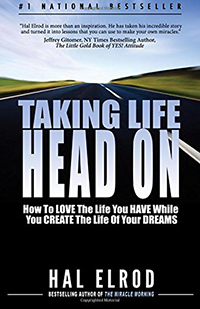
I thought, “Okay, I got to figure out which one to do.” I thought, “What if I did all of these? That would be the ultimate ritual for personal development.” What if I did all of the six most proven powerful personal development practices known to man? The final question was when. As I’m going through and doing this Google searching, I keep coming across morning rituals and early rising as being one of the common themes of the world’s most successful people but I wasn’t a morning person. I was resisting that. Going, “No, no, no, no, no, no, yeah, yeah, yeah. Getting up early, great. What else do they do?” Like what else are they? Where’s the night owl? Finally, it was staring me in the face over and over and I thought, If I want my life to get better, this is true for everybody, it’s a universal principle. If we want our lives to get better, we have to get better first. We have to do something different if we want to make our life different.
I thought, I’m going to do it, I’m going to wake up an hour earlier. Oh, that sounds terrible, but I’m going to do it. I’m going to wake up an hour earlier and I’m going to do all six of the world’s most proven personal development practices. I woke up the next morning, did all six. Even though I was $52,000 in credit card debt on my personal credit card, my house was in foreclosure, I was triple the body fat percentage that I had been six months prior, and I’ve been depressed, I didn’t feel that way anymore. I thought if I start every day like this, with this much clarity and purpose, and knowledge, the things that I’ve gained. Just the very first day, if I do this every day, then that compound effect, it’s only a matter of time before I develop myself into the person, as Jim Rohn said, that I need to be to create the success I want in my life. The last thing I’ll say on this is that I had no idea how fast it would happen, I was thinking kind of like the walking thing. Six to twelve month. It was less than two months after my very first miracle morning, it wasn’t called that, it didn’t have a name in the beginning.
Less than two months later, I’m more than double my income. I got in the best shape of my life. I committed to run a 52 mile ultra-marathon because I hated running. I thought what better way to grow as a person that run 52 miles in one day. The income doubled and my depression went away on the very first day. Because my life transformed so quickly, I started calling it my Miracle Morning. It was never going to be a book. I shared it with one coaching client within a few months and she said, “Hal, I’m not a morning person but what you say makes sense, I’ll try it.” A week later, she got on the phone with me and she says, “Hal, oh my gosh. I took those little tips that you suggested for the beating the snooze button. It was easy and I did what you said. I had the best week in my sales career. I finished an entire self-help book.” I forgot what else, exercising, whatever. That was when the light bulb went off. I thought if this changed my life and I wasn’t a morning person.
Katie, my client, was not a morning person, it is changing her life within a week. This could change the world. This could change anyone’s life. Because writing is challenging, it took three years. But now those six practices, the beating the snooze button, the best of the best, all of that is kind of what makes The Miracle Morning what it is. It’s how do you beat the snooze button so you can wake up early, even if you’re not a morning person. Once you’re up, what do you do during that first 30 to 60 minutes to accelerate your personal development so you can see results in whatever area of your life you choose. You apply The Miracle Morning to your fitness, your relationships, your income, your business, whatever. You just accelerate how quickly you become the person that can create the results that you want.
Right, is this personalized or is it just kind of one size fits all? Like you’re going to do two minutes planks, and you’re going to jump up and down on a rebounder to emphasize, do some affirmations for three minutes, and so forth. Or is it like, well, I want to do gratitude mediation in the form of heart breathing, or I want to do let’s say some TM, transcendental meditation. What would be the process for somebody who’s never done a morning ritual before but is intrigued?
Great question. It is completely customizable. Real quick, I’m going to teach the framework, the six practices. This will give you an idea of how you can customize. The six practices are an acronym known as the SAVERS, which by the way I always give my wife credit because I was writing the book frustrated one day and she goes, “What’s wrong, sweetheart?” I said, “Everyone’s got a framework like Stephen Covey has the 7 Habits, Robert Kiyosaki’s got the Cash Flow Quadrant. These six practices are so totally random. I don’t know how to organize them in a way that makes it memorable, and simple, and implementable.” She goes, “Why don’t you get a thesaurus and see if you can make an acronym?” I was like, “You’re brilliant.” It’s funny but I didn’t know at the time but these six practices, this acronym would become as important as The Miracle Morning concept in general. People check in everyday in our, we have a Facebook group with 50,000 people at The Miracle Morning Community.
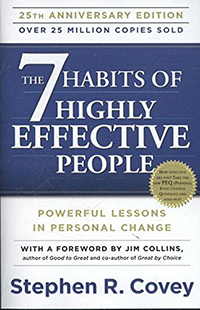
People check in every day. They mention doing their SAVERS or ask questions about their SAVERS as much as they do about The Miracle Morning in general. Here are the six practices. The first S is for silence. That’s an example of how customizable it is. Silence could be meditation for some people, it can be any form, it could be guided, it could be transcendental, it could be any form of meditation. Or it could be prayer, or it could be a combination of both, which probably for the majority, it kind of is a combination of the two. The A is for affirmations. The way that I teach affirmations in the book is very different than-affirmations have been taught for decades by self-help gurus, if you will. I’ll teach this in a way so people can implement it right away, you don’t have to read the book to implement this. The way the affirmations have been taught, one of two ways that are both pretty faulty.
One is to lie to yourself. If you want to be a millionaire, we’re taught to use the words I am, the two most powerful word in the English language. I am a millionaire. I am a millionaire. I am a millionaire. Just say it over and over until you trick yourself into believing it. With all that, I believe that there’s validity that that approach can work. If you tell yourself something, you have to believe it. However, I don’t believe lying to yourself is ever the optimal approach or strategy. The truth will always prevail. If you go, “I’m a millionaire,” but you’ve only got $5,000 in the bank or more or less, your subconscious goes, “No, you’re not.” We’re smart, we can’t really fool ourselves. You’re fighting reality when you try that approach. The other way affirmations have been taught are in a way that’s very passive, such as, here’s an example of a money affirmation that’s kind of in one form or another has been very popularized. It’s money flows to me effortlessly and in abundance.
I’ve heard that, yes.
Yeah, right. But no it doesn’t. Anyone who’s wealthy would probably tell you, “I didn’t sit back in a week for money to flow to me effortlessly. I actually worked my butt off. I had to create a lot of value for the world, for the market place, and then money showed up.” Those are the two ways that affirmations have been popularized over the years. I think that most people left a bad taste in their mouth. Affirmations are cheesy, they don’t work, I’ve tried them, they don’t resonate, yada, yada, yada. The way that I teach affirmations, and I’ll teach everybody right now, it’s essentially four steps.
For me, I want affirmations to be rooted in truth. I want them to be result-oriented so they produce results for me and not just make me feel good. I want them to be actionable. I want them to change or influence my behavior in a way that’s going to produce the results that I’m affirming. Instead of saying I’m a millionaire, here’s the four steps. Number one is, what is your ideal outcome? I usually phrase it with, instead of I am _______, it’s I am committed to becoming _______. That’s rooted in truth. It’s also important that you’re reinforcing your level of commitment. I’m committed to becoming a millionaire. Step two is what’s the why. What are the benefits of that, the reason that’s behind it that’s going to compel you to work towards it each day? I am committed to becoming a millionaire so I can provide financial security and freedom for my family and myself.
Third is, what’s the specific action that you must take in order to achieve that result? I’ll just use a general. Every day from [8:00]AM to [10:00]AM or [8:00]AM to [9:00]AM, or [6:00]AM to [8:00]AM, whatever. Every day from this time to this time, or every Saturday, I will do _______; whatever that action is for you that is going to move you towards to becoming, whatever, a millionaire in this case. Fourth is the when. This is where the rubber meets the road. It’s not just affirming what you’re going to do and adding it to the bottom of a to-do list that never gets done. Therefore, I will take _______ action, number three, at _______ time and day. You are affirming what you want, number one. Number two, why you want it. Number three, what you will commit to doing to ensure that you achieve it. And number four, when specifically you’re going to schedule that activity. That’s the formula that I suggest and that I use for affirmations, so that they’re rooted in truth, they’re compelling, they clarify the action you need to take, and get you into action by clarifying when you’re going to take it. Anything to add to that or questions? Then I can keep going through the SAVERS.
You are affirming what you want, number one. Number two, why you want it. Number three, what you will commit to doing to ensure that you achieve it. And number four, when specifically you’re going to schedule that activity. Click To TweetYes, a few things. First of all, I love affirmations, I use them all the time. Some of the affirmations I use include I’m intentional in everything I do, I show up powerfully. Yet, they don’t really fit your formula. I’m not always intentional but that’s what I endeavor to be. By saying that affirmation, I’m definitely more intentional throughout the day. When you’re intentional, you don’t have downtime, you just show up and you have an intention whether you’re going to a family reunion, or you’re going to a movie, or you are making a sales call. How would you improve an affirmation like I’m intentional in everything I do, based on your formula?
I’m glad you brought this up because a disclaimer, an affirmation to me is anything that you think or say. You’re affirming it to yourself. Therefore, this formula isn’t the only way to do affirmations. I have some affirmations that just remind me how great my life is. They’re not about generating any kind of results. It’s just reading it, affirming it, because it reminds me to be present to how beautiful life is, etc. This formula is one way of doing affirmations. To me, it’s taking the old way that’s been taught and giving it something that’s more effective. To your point, I would say I am committed to being intentional in everything that I do because in doing so I will be able to achieve my dreams, I’m just going off the cuff here. If you can actually find a way to make it actionable, therefore, before each action that I take, or every hour, I will set a timer that reminds me to be intentional, or asks me have you been intentional the last hour or is there anything you need to change? It’s an example of making it very specific and actionable, and ensuring that it doesn’t just make you feel good while you read it, but it actually creates results perpetually throughout the rest of your day.
I like that. How many affirmations do you think is a good number? How many are too much? I try and keep it only maybe a few different affirmations that I’ll say in the morning. If I do like 15 different affirmations, I kind of lose track of it all.
Sure. Yeah, I’m a bad example. My affirmations, I’m always editing them, and adding to them. My affirmations end up growing into pages and pages then I always have to schedule a time to go through, cut the fat, prioritize. A good way to start is to use affirmations for your goals. Whatever your goals are for the year, create affirmations that support each of those goals, like your most important goals. It’s a good way to do it. Again, there’s no hard and fast rule of how many is too many, I think you just have to ask yourself, are these effective? Or like you said, is it too many? Are they watered down, is everything getting lost in the shuffle? Is it kind of a quantity over quality thing? If it is, then just reassess and decide which of these.
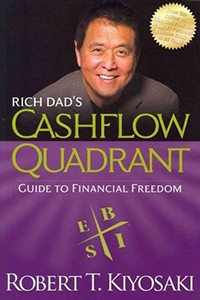
A way to do that, by the way, is to break your affirmations in the morning and in evening. Maybe the morning affirmations are the ones that are related to your goals and your actions. This is if you have too many and you want to break them up, but you don’t want to get rid of them. Evening is the affirmations that kind of program you to go to sleep feeling really grateful, and really peaceful, and really happy, and really optimistic, that sort of things. Maybe you have more results-oriented affirmations in the morning that get you into action towards your goals, then the evening kind of reinforcing the emotional well-being that you want. In that way, that’s kind of being nurtured in your subconscious while you sleep.
Yeah. I’ve actually created an audio where I put some classical music in the background and then I recited some affirmations, put that into an mp3 file, then listened to that. That’s pretty cool.
That’s really cool.
Have you ever done that or anything like this one?
I haven’t. A lot of people in our Miracle Morning Community, the Facebook group will, they’re not a lot, but I do see that people either ask about that or they’ll mention like, “Hey I read my affirmations into a voice recorder. Now, I listen to it on my phone when I drive, or in the morning, or whatever. It’s really powerful hearing my own voice.” It’s something that I have yet to do but I think it’s a cool idea.
Yeah, give it a try. I’ve heard that classical music is kind of part of the secret sauce of it. Having that play in the background while you’re listening to your affirmations is an important piece. Yeah, give it a try.
I would imagine that’s true. I think there’s a lot of evidence, scientific evidence of the power of music, especially classical or binaural beats, or that type of thing.
Right. One last question about affirmations and we’ll move on to the rest of the SAVERS formula. Do you do it with any kind of strong energy? Like for example while jumping, or on a rebound, or anything? I do it on a rebounder, my affirmations in the morning. Or is it just lying down when you’re in a meditative state? What’s the optimal kind?
Yes. I think it’s to each their own. Although I do believe there’s got to be some sort of, I don’t know if intensity is the right word, but the emotional investment in your affirmations because that’s where the depth of the imprint on your subconscious mind and your conscious mind is really in correlation with the emotional intensity. An investment that you’re attaching to the affirmation. It sounds like if somebody says, “You’re a moron,” you go, “Okay, you’re kind of a jerk.” But if somebody went in your face and like God, their face is red and they screamed, “You’re a moron,” it would probably make a much more lasting impact on you. You probably wouldn’t forget it the whole day. The intensity of the experience that we give ourselves when we’re doing our affirmations. Intensity, I’m into positive intensity, “I’m really committed to this,” like really feeling it. For me, personally, I just do them sitting on the couch. I go read them that way.
Got it, okay. What’s the rest of the SAVERS formula?
The V is for visualization. We don’t have time for us to go in-depth on it. But in the book, I do something similar to an affirmation, where I talk about how the way it’s been taught over decades is not optimal, I don’t believe. If you just make a vision board and stare at it, or picture yourself crossing the finish line. Research has shown that actually be counterproductive and you can trick your mind thinking that the result is going to happen, therefore, there’s not as much need for you to take the action because you’ve seen it so many times, it just feels real.
I teach how to visualize not just the end result, but the actual actions steps and get yourself to do the things that you would normally find yourself resisting.
In the book, I teach how to visualize not just the end result, but the actual actions steps and get yourself to do the things that you would normally find yourself resisting and how to use visualization in that way. I think what’s important to understand is if you look at the world’s top athletes, there are very few that do not swear by visualization. From Tiger Woods when he was the best in the world to Michael Jordan, all of the above. That is a practice. The E is for exercise with SAVERS. I’m not saying that you can’t go to the gym in the afternoon, or the evening, or whatever. It’s just as little as 60 seconds of exercise in the morning. 60 seconds of jumping jacks will up your blood and oxygen to your brain significantly. That’s just a minute. Do it for five minutes or whatever, or even more. You have more willpower, you have more energy to sustain throughout the day, etc., etc. A little bit of exercise in the morning is a key.
The R is for reading. Obviously, not like Fifty Shades of Grey, or Harry Potter books, or whatever. The new one’s out, my wife just got that. Reading books, self-help books, professional development books, books that will move you closer to your goals. The final S is for Scribing, thanks to the source and my beautiful wife. The fancy word for writing or journaling. Typically, journaling is one of the most proven, sworn by practices of people like Tony Robbins and a lot of very successful people. Robert Kiyosaki, who wrote Rich Dad Poor Dad, he reached out to me, or his assistant at first. Basically, he read The Miracle Morning three times, which my jaw hit the floor when I found that out. He says it’s completely changed his life, it’s improved his marriage. They do it together, he and his wife did it together.
He interviewed me on Rich Dad Radio because of that. He said it the best, I’m paraphrasing, anyone of the lifesavers, every successful person on the planet swears by one of these. He goes, “I’ve never heard of anyone, before The Miracle Morning, I never heard anybody doing all six of these ancient best practices.” That’s what makes The Miracle Morning so life-changing, you’re leveraging not just one, not two, not three, but six of the most proven practices that the world’s most successful people do. He says he does all six now every single day. It’s part of his Miracle Morning. He said it best to summarize why The Miracle Morning, and why the SAVERS are getting such great results for people.
That’s awesome. This idea of the 13 Principles of Think and Grow Rich that made these mega moguls back in the day are applied to real-world situations. A nice package in the morning, and that’s The Miracle Morning. This is how the rubber meets the road, essentially.
I completely agree.
Yeah. A couple of quick questions regarding the SAVERS. Exercise, any particular direction. For example for me, I think working my core, this is feedback I’ve been given, is really a critical piece. Doing planks is much more recommended to me than jumping jacks. Cause yeah, it’s good to get my heart rate up and so forth, but when you work your core, you show up more powerfully. You are a rock for your significant other and so forth. That seemed to resonate with me. That’s what I’ve been working on lately, any thoughts on types of exercises?
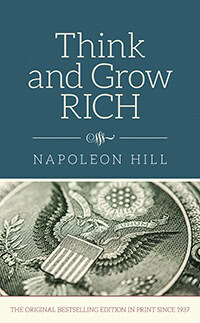
Yeah. I think it’s probably a preference. Wherever there’s the least resistance for someone to just get started. If that’s a minute of jumping jacks, that’s a great way to start. Yoga is my favorite form of exercise. If you had to pick one, anything it’s strengthening your core, depending on the yoga, but typically strengthening the core. It’s also a really obvious improving flexibility. If I have to pick one form of exercise that I would do, it’s yoga. One thing I recommend and I do myself is there’s a great app called 7 Minute Workout. If you don’t like exercising, it’s one of the greatest workout routines because you don’t do any exercise longer than 30 seconds. I’m ADHD so my attention span is, I don’t like doing much for very long. It’s like, “Oh cool. I can do 30 seconds of this, then I get to switch, awesome. 10-second break, great. 30 more seconds of something else, awesome.” All of a sudden seven minutes goes by before you know it and you had a really great full-body workout.
Nice. The reading, for how long would you recommend reading? Cause if you’re just trying to fit everything and SAVERS into let’s say half hour, that might give you ten minutes. It’s not going to take you very far to read some of these great personal development books, 10 minutes at a time. It’s better than nothing. What’s kind of the ideal here?
If you think about it, if you read 10 pages a day, it doesn’t feel like a lot but at the end of the year, that just 3,650 pages or the equivalent of 18, 200-page self-help books. If you actually quantify, you go wow. I don’t know too many people that read 18 books a year. A book and a half every month. If you’re been a little slower, get down to a book a month or whatever. If you’re applying, if you’re reading books that are in alignment with the areas of your life or business that you want to improve, you’re going to be ahead of the game, ahead of your competition.
Most people do a one hour Miracle Morning. But it is scalable, there’s a whole chapter in the book on how to do a six-minute miracle morning and actually get results. Like your point 30 minutes, I usually tell people for your first month, the Miracle Morning challenge is 30 minutes for 30 days. Keep it simple. You can customize it but for most people to do a one hour Miracle Morning, they might do five minutes of silence, five minutes of affirmations, five minutes of visualization, then 20 minutes of exercise, 20 minutes or reading, and 5 minutes of scribing. There’s one hour. Of course, you can shorten or lengthen any of those.
My very first Miracle Morning was just 10 minutes of each. Just broke it to be billion, that’s how I felt and just played with it. The same thing, if you start with 30 minutes, do five minutes of each of the SAVERS, and go from there. I even tell people, some people if they’re just getting started. I go, don’t wait until you have read the book to get started. If you’re listening to this right now, here are two simple steps. Back up your alarm clock by 30 minutes so that way you’re waking up each day with discipline and purpose, not when you have to wake up to go to work, but when you want to wake up to improve yourself. Wake up 30 minutes earlier, set the alarm clock back, move the alarm clock across the room, that’s one of the five steps to beat the snooze button. If the alarm clock is by your bedside table which is where most of us keep it, then you’re still in dreamland when you’re debating whether not to turn off the snooze button. Hit the snooze button, you’re reaching over and hitting the snooze button every time. If you have to get up and get out of the bed and walk across the room, you’re five times more awake than when you’re in that dream state, you just reach over at the snooze button in your bedside table. Set the alarm clock back 30 minutes, move your alarm clock across the room, and do one of the SAVERS.
Until you learn the other SAVERS, or do whatever you want. For many people, they’ll just do 30 minutes of reading and they’ll read the book itself. They’ll read The Miracle Morning for 30 minutes a day until they get to the SAVERS chapter. Then, they start adding silence, they’re like, “Okay, I’ll go meditate a little bit, and do the reading, then add in affirmations.” That’s it. It’s not about an all or nothing idea. I think that holds us back so often is all or nothing mentality. You’re better off to do something rather that everything perfect. Set your alarm back 30 minutes, move it across the room, and start with one of those six practices for just 30 minutes, or if you want to do two. That’s fine. 15 minutes of reading, 15 minutes of exercise, whatever works for you, just get started is the most important part.
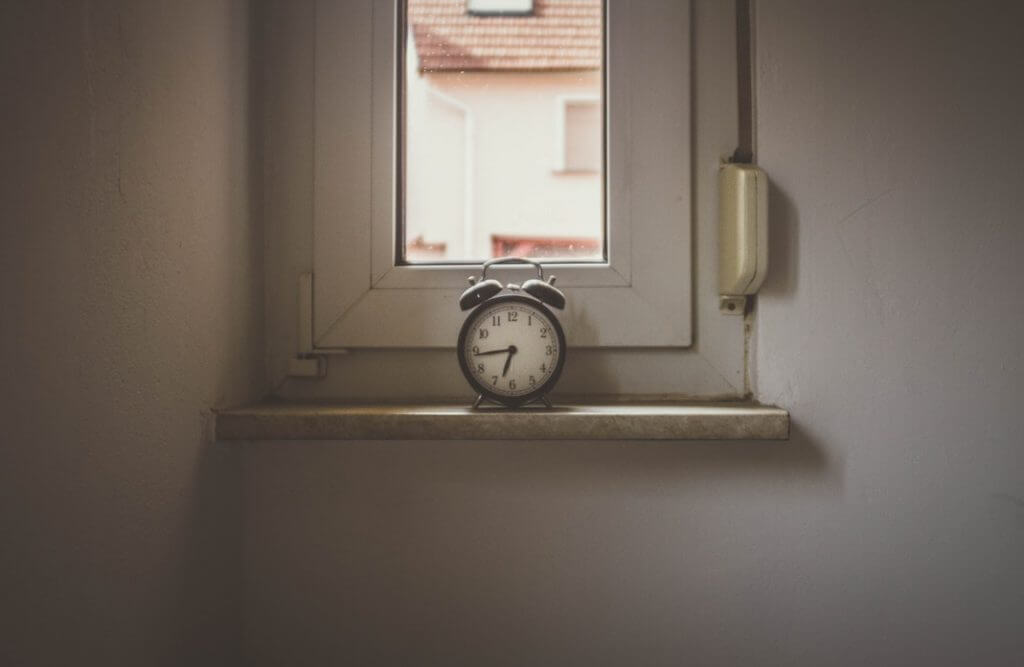
Are people reading, like are you reading outside of the morning ritual as well? Like hours a week or is it all can find within that morning ritual?
It’s within the morning but my morning is long. I wake up at 3:30 am every day, I do the SAVERS from [4:00] to [5:00]. I often do an extended period of reading from [5:00] to [6:00], like a whole hour of reading. It just depends on what’s going on in my business, my scheduled projects, and stuff. Yes, it is the morning time, I don’t read usually in the other time.
Wow. Are you getting enough sleep? Can I ask?
Yeah, I get six hours of sleep. I talk about that in the book. There’s a lot of science, there are studies that have shown that eight is optimal. The perpetuated amount is eight hours of sleep but there’s a lot of studies that show seven is ideal, six is ideal. What you find is actually depending on the person. It’s actually different for each person. Also, there are a lot of variables. For example, if you eat a poor diet, your body is detoxing all night. It’s trying to process all the crap, the poison you gave it, so you actually need more sleep. In fact, you can get way more sleep that someone who eats a really clean diet. You get more sleep then but you actually will feel more tired in the morning cause you eat unhealthy food, your body is detoxed by night. It’s dealing with the poison. If you eat a really healthy clean diet, you don’t have any poison to deal with at night, you’re going to feel a lot better in the morning. It’s a lot of variables, you’ll see in the book, it talks about how to adjust your sleep, test your sleep, how you can get more energy off of less sleep, there’s a whole chapter dedicated to that.
Yup. Deep sleep is really the most important currency that you’re after. I have a Zeo that I strapped in my forehead, not every night. I just want to check, make sure I’m getting at least an hour of deep sleep at night even if it’s only six hours of sleep total.
How do you spell Zeo? I got to buy one of those.
Yeah, they’re not for sale anymore unless you find them on eBay because the company went out on a business. I’m sure you can find one on eBay, Zeo, it’s got a matching app. It’s really cool. Getting just an app for your phone that you set on your bed, checks to see if you’re moving at night. It’s a very poor approximation of deep sleep. Actually measure your brainwaves. I know you’ve got to go. Last, last quick question is how do people find your book and other resources to change their mornings to thus change their lives? I think you do live events as well, for example.
Yeah. We have a live event every December in San Diego, where the weather is nice. It’s called Best Year Ever Blueprint. You can get all the details at bestyeareverlive.com. It’s a pretty incredible event. I would say go to the website and watch the video. You’ll know within three minutes that you do not want to miss it, or if you don’t ever want to come near it. It’s pretty obvious. To get The Miracle Morning, Amazon usually is the best place, Paperback, Hardcover, Kindle, Audible, those are all available on Amazon. If you’re an iBooks user, you can get it on the iPhone or the iPad or whatever.
My website is my name, halelrod.com. Last but not the least, you’ll see this in the book but join The Miracle Morning Community Facebook Group. It really has become like a case study. It’s one of the most engaged, supportive, positive, online communities in the world right now. Just growing rapidly every day. Somehow maintaining this quality of engagement even with 50,000 plus members from 70 countries. I always tell people to join the community even before you get the book. It’s just a great place to connect to people. Even to see evidence of like wow, this is crazy seeing how many people are changing their lives with this whole morning ritual and most of them weren’t morning people to begin with.
Awesome. Alright, thank you, Hal. Thank you, listeners, as well. We’ll catch you on the next episode. This is Stephan Spencer signing off.
Important Links
Checklist of Actionable Takeaways










 About Hal Elrod
About Hal Elrod
Hal Elrod died at age 20. After being hit head-on by a drunk driver at 70 mph, he died for 6 minutes, broke 11 bones, and was told by doctors that he would never walk again. Not only did he walk, but he also ran a 52-mile ultra-marathon, became a hall of fame business achiever, an international keynote speaker, and #1 bestselling author of The Miracle Morning, which is one of the highest-rated books on Amazon with over 1,300 five-star reviews.
Disclaimer: The medical, fitness, psychological, mindset, lifestyle, and nutritional information provided on this website and through any materials, downloads, videos, webinars, podcasts, or emails is not intended to be a substitute for professional medical/fitness/nutritional advice, diagnoses, or treatment. Always seek the help of your physician, psychologist, psychiatrist, therapist, certified trainer, or dietitian with any questions regarding starting any new programs or treatments, or stopping any current programs or treatments. This website is for information purposes only, and the creators and editors, including Stephan Spencer, accept no liability for any injury or illness arising out of the use of the material contained herein, and make no warranty, express or implied, with respect to the contents of this website and affiliated materials.
LOVED THIS EPISODE
Please consider leaving me a review with Apple, Google or Spotify! It'll help folks discover this show and hopefully we can change more lives!
Rate and Review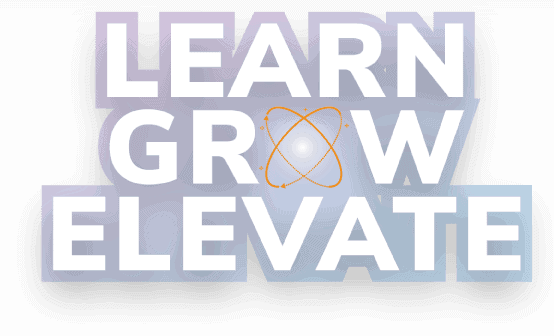
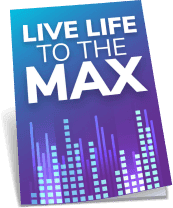






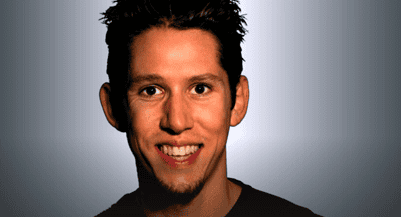
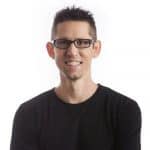 About Hal Elrod
About Hal Elrod